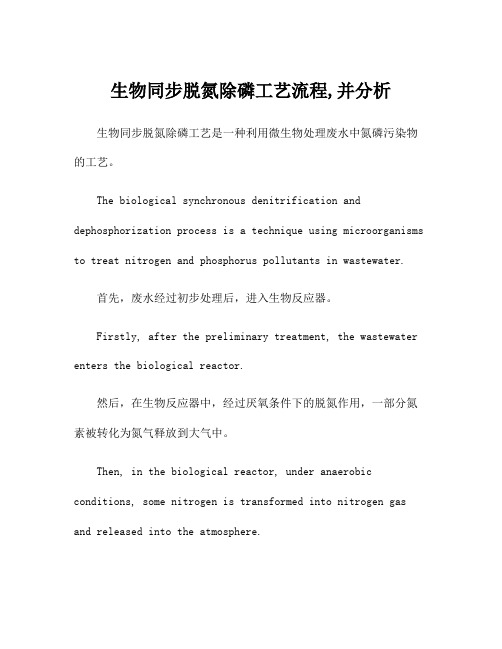第4章 生物脱氮除磷工艺
生物脱氮除磷原理及工艺

(2)反应过程 (3)反硝化反应的控制指标
①碳源
污水中的碳源,BOD5/T—N>3-5时,勿需外加 外加碳源,CH3OH(反硝化速率高生成CO2+H2O),
②PH值
当BOD5/T—N<3-5时
适当的PH值(6.5-7.5) ——主要的影响因素
PH>8,或PH<6,反硝化速率下降
8
同化反硝化
+4H
+4H
缓慢搅拌池
沉淀池
21
三、 生物除磷原理
霍米尔(Holmers)提出活性污泥的化学式 C118H170O51N17P 或C:N:P=46:8:1
※ 生物除磷——就是利用聚磷菌一类的的微生物,能够过量 的,在数量上超过其生理需要,从外部摄取磷,并将磷以聚合 形式贮藏在菌体内,形成高磷污泥,排出系统外,达到从废水 中除磷的效果。
设内循环
产生碱度,3.75mg碱度/mgNO3—N 勿需建后曝气池
回流水含有NO3—N(沉淀池污泥反硝化生成)
要提高脱氮率,要增加回流比
(2)影响因素与主要工艺参数
水力停留时间:3 :1; 循环比:200%; MLSS值:大于3000mg/l; 污泥龄:30d; N/MLSS负荷率:0.03gN/gMLSS.d 进水总氮浓度:小于30mg/l。
活性污泥法的传统功能——去除水中溶解性有机物
1、同化作用
污水生物处理中,一部分氮备同化微生物细胞的 组分。按细胞干重计算,微生物中氮的含量约为 12.5%
4
2、氨化反应 与硝化反应 (1)氨化反应
RCHNH2COOH+O2氨化菌 RCOOH+CO2+NH3
3、硝化反应
(1)硝化过程
生物脱氮除磷工艺

生物脱氮除磷工艺生物脱氮除磷工艺是一种通过微生物代谢作用来减少废水中氮和磷的浓度的工艺。
该工艺逐渐被广泛应用于城市污水处理、农业生产、工业废水处理等领域。
生物脱氮除磷工艺涉及多个过程,包括生物脱氮池、一/二级沉淀池、生物滤池、化学除磷装置等。
其中生物脱氮池和生物滤池是主要的过程单元。
生物脱氮池是一个特殊的好氧反应器,主要是使用异养菌为营养基础,利用硝化反应将氨氮和有机氮转化为硝态氮,然后通过反硝化反应将硝态氮还原为氮气排出。
为了使池内的好氧环境被保持,池内需要提供足够的氧气。
生物滤池是一个非常重要的污水处理单位,它是通过微生物群落代谢作用,利用吸附作用来吸附废水中的氮和磷元素。
微生物生长在滤料表面,铺设在水平或者竖直的格栅上,滤料可以是沙砾、玄武岩等物质。
滤料的特殊结构、表面特性和自备的微生物群落成为生物滤池内的去除污染物的主要手段。
废水在流经滤料层时,氮和磷元素在滤料表面被吸附,吸附到细胞表面的氮被异养菌氧化为氮气,磷元素则随着污泥浓度增加,在池内逐步沉积。
生物脱氮除磷工艺的优点在于原理简单,适用范围广泛,处理效率高,成本较低,不需要大量的化学物质,并且不会产生二次污染。
然而,这种工艺也存在一些缺陷。
例如,处理后的产物含有大量的氮和磷,商业利用它们困难,造成浪费;污水中如果有过多的脂肪和油脂,可能会对生物脱氮除磷工艺产生影响,导致工艺失效。
总之,生物脱氮除磷工艺是一种受到广泛关注的废水处理方案。
未来,随着社会对环境保护意识的不断提高,生物脱氮除磷工艺势必会在更多的领域得到应用,成为减少污染物排放的重要手段。
工艺方法——生物脱氮除磷技术

工艺方法——生物脱氮除磷技术工艺简介一、传统生物脱氮除磷技术1、传统生物脱氮原理污水经二级生化处理,在好氧条件下去除以BOD5为主的碳源污染物的同时,在氨化细菌的参与下完成脱氨基作用,并在硝化和亚硝化细菌的参与下完成硝化作用;在厌氧或缺氧条件下经反硝化细菌的参与完成反硝化作用。
2、传统生物除磷原理在厌氧条件下,聚磷菌体内的ATP进行水解,放出H3PO4和能量形成ADP;在好氧条件下,聚磷菌有氧呼吸,不断地放出能量,聚磷菌在透膜酶的催化作用下利用能量、通过主动运输从外部摄取H3PO4,其中一部分与ADP结合形成ATP,另一部分合成聚磷酸盐(PHB)储存在细胞内,实现过量吸磷。
通过排除剩余污泥或侧流富集厌氧上清液将磷从系统内排除,在生物除磷过程中,碳源微生物也得到分解。
3、常用工艺及升级改造具有代表性的常用工艺有A/O工艺、A2/O工艺、UCT工艺、SBR 工艺、Bardenpho工艺、生物转盘工艺等,这些工艺都是通过调节工况,利用各阶段的优势菌群,尽可能的消除各影响因素间的干扰,以达到适应各阶段菌群生长条件,实现水处理效果。
近年来随着研究的深入,对常用工艺有了一些改进,目前应用最广泛、水厂升级改造难度较低的是分段进水工艺。
与传统A/O工艺、A2/O工艺、UCT工艺等相比,分段进水工艺可以充分利用碳源并能较好的维持好氧、厌氧(或缺氧)环境,具有脱氮除磷效率高、无需内循环、污泥浓度高、污泥龄长等优点。
分段进水工艺适用于对A/O工艺、A2/O工艺、UCT工艺等的升级改造,通过将生化反应池分隔并使进水按一定比例分段进入各段反应池,以充分利用碳源,解决目前污水处理厂普遍存在的碳源不足和剩余污泥量过大的问题。
分段进水工艺虽然对提高出水水质有较好的效果,但该工艺并不能提高处理能力,当水厂处于超负荷运行时,分段进水改造也不能达到良好的处理效果。
二、新型生物脱氮除磷技术近年来,科学研究发现,生物脱氮除磷过程中出现了超出传统生物脱氮除磷理论的现象,据此提出了一些新的脱氮除磷工艺,如:短程硝化反硝化工艺、同步硝化反硝化工艺、厌氧氨氧化工艺、反硝化除磷工艺。
污水生物脱氮除磷原理及工艺

一般用Al2(SO4)3,聚氯化铝(PAC)和铝酸钠(NaAlO2) 2)铁盐除磷:FePO4 、 Fe(OH)3
一般用FeCl2、FeSO4 或 FeCl3 、Fe2(SO4)3
3)石灰混凝除磷:
2 5Ca 2 4OH 3HPO4 Ca5 (OH )(PO4 ) 3 3H 2O
二、生物除磷过程的影响因素
①溶解氧: l厌氧池内:绝对的厌氧,即使是NO3-等也不允许存在; l好氧池内:充足的溶解氧。 ②污泥龄: l剩余污泥对脱磷效果有很大影响,泥龄短的系统产生的剩余
污泥多,可以取得较好的除磷效果;
l 有报道称:污泥龄为 30d ,除磷率为 40%;污泥龄为 17d,
除磷率为50%;而污泥龄为5d时,除磷率高达87%。
一、巴颠甫(Bardenpho)同步脱氮除磷工艺
工艺特点: 各项反应都反复进行两次以上,各反应单元都有其首要 功能,同时又兼有二、三项辅助功能; 脱氮除磷的效果良好。 工艺复杂,反应器单元多,运行繁琐,成本高
二、A—A—O(A2/O)同步脱氮除磷工艺
工艺特点: l工艺流程比较简单;总的水力停留时间短 l厌氧、缺氧、好氧交替运行,不利于丝状菌生长,污泥膨胀 较少发生; l无需投药,两个A段只需轻缓搅拌, 只有O段供氧, 运行费用低。
3
2
2 反硝化反应的影响因素
• 碳源:
①废水中有机物,若BOD5/TKN>3~5时,即可; ②外加碳源,多为甲醇; ③内源呼吸碳源—细菌体内的原生物质及其贮存 的有机物。 • 适宜pH:6.5~7.5; • 溶解氧应控制在0.5mg/l以下;
• 适宜温度:20~40C
生物脱氮的基本原理
二、Phostrip除磷工艺——生物除磷和化学除磷相结合
生物同步脱氮除磷工艺流程,并分析

生物同步脱氮除磷工艺流程,并分析生物同步脱氮除磷工艺是一种利用微生物处理废水中氮磷污染物的工艺。
The biological synchronous denitrification and dephosphorization process is a technique using microorganisms to treat nitrogen and phosphorus pollutants in wastewater.首先,废水经过初步处理后,进入生物反应器。
Firstly, after the preliminary treatment, the wastewater enters the biological reactor.然后,在生物反应器中,经过厌氧条件下的脱氮作用,一部分氮素被转化为氮气释放到大气中。
Then, in the biological reactor, under anaerobic conditions, some nitrogen is transformed into nitrogen gas and released into the atmosphere.在同一时间,另一部分废水中的氮素被转化为氮氧化物,并在需要氧气的氧化条件下被进一步处理。
At the same time, another portion of nitrogen in the wastewater is converted to nitrogen oxides and further treated under aerobic conditions requiring oxygen.除氮后,废水进一步进入磷的处理阶段。
After denitrification, the wastewater further enters the phosphorus treatment stage.在此阶段,废水中的磷会被吸附到生物污泥上,从而将磷从废水中去除。
《生物脱氮除磷》课件

有机物浓度和泥龄对生物除磷的影响也 较大,适宜的有机物浓度和泥龄需要针 对不同的工艺进行优化。
溶解氧浓度对生物除磷的影响较大,适 宜的溶解氧浓度范围为0.5-3mg/L。
温度对生物除磷的影响较大,适宜的温 度范围为10-30℃。
pH值对生物除磷的影响也较大,适宜的 pH值范围为6.5-8.5。
04 生物脱氮除磷技 术案例分析
温度
温度对生物脱氮效率有显著影 响,适宜的温度范围是20-30℃
。
pH值
pH值对硝化细菌和反硝化细菌 的生长和活性有重要影响,适 宜的pH值范围是7.0-8.0。
溶解氧
溶解氧对硝化反应和反硝化反 应均有影响,适宜的溶解氧浓 度是2-4mg/L。
碳源
碳源的种类和浓度对反硝化反 应有重要影响,常用的碳源有
某污水处理厂生物脱氮除磷运行管理
运行管理要点
为确保生物脱氮除磷工艺的稳定运行,需要定期对工艺参数进行监测与调整,如溶解氧、 pH值、温度等。同时,需要加强设备维护与保养,确保设备的正常运行。
应急处理措施
针对可能出现的异常情况,如污泥膨胀、污泥流失等,制定相应的应急处理措施,确保工 艺的可靠性。
人员培训与安全管理
某污水处理厂生物脱氮除磷效果分析
1 2 3
脱氮效果
通过合理的工艺控制,该污水处理厂的生物脱氮 效率较高,总氮去除率达到85%以上,满足国家 排放标微生物的聚磷作用,有效去除 磷元素,总磷去除率达到90%以上,显著降低水 体富营养化的风险。
经济效益与社会效益
该工艺的运行不仅提高了污水处理效果,减少了 污染物排放,同时也为污水处理厂带来了经济效 益和社会效益。
原理
生物脱氮基于硝化反硝化原理,通过好氧硝化和缺氧反硝化过程实现氮的去除 ;生物除磷则通过聚磷菌在厌氧和好氧环境下的代谢作用实现磷的去除。
(完整版)生物脱氮除磷工艺的比较

2.除磷系统的效率影响因素。
①PH 7-8之间;②好氧区中溶解氧2mg/L以上;/P大于10,出水P浓度可降至1mg/L左右;③进水中易降解COD浓度,当BOD5④低污泥负荷和高SRT对除磷过程不利。
当SRT较长时,聚磷菌处于较长的内源呼吸期,会消耗细胞内较多的贮存物质,影响厌氧区对VAF的吸收和PHB的转化,使整个系统的除磷效率降低。
3.A2/O过程中P去除效果变差的原因。
(2012)①进入沉淀池的混合液通常需要保持一定的溶解氧浓度,以防止沉淀池中反硝化和污泥厌氧释磷,但这同时导致回流污泥和回流混合液中存在一定的溶解氧,影响厌氧释磷过程;②回流污泥中存在的硝酸盐进行反硝化作用,消耗系统中的易降解COD造成碳源不足的问题;③系统所排放的污泥中仅有一部分是经历了完整的厌氧和好氧过程,影响了污泥的充分吸磷;④系统污泥泥龄因为兼顾硝化菌的生长而不可能太短,导致除磷效果难以进一步提高。
4.氨氮的氨氧化原理。
(2013)5.结合N去除的工艺流程,浅述氨氮和总氮的去除途径。
(2012)6.论述生物脱氮除磷中,碳源的重要性以及碳源不足时应采取什么措施(2011)(2009)碳,是微生物生长需要量最大的元素。
在脱氮除磷系统中,碳源大致上消耗于释磷,反硝化和异养菌正常代谢等其他方面,其中释磷与反硝化过程的反应速率与进水碳源中易降解部分,尤其是挥发性有机脂肪酸(VFA)的数量关系很大。
在生物脱氮的缺氧区,易降解COD浓度越高,则硝酸盐反硝化速率越快,缺氧池容积可以减少,反硝化效率高;在生物除磷的厌氧区,易降解COD浓度越高,释磷越充分,除磷效果越好。
解决方法:一从工艺外部采取措施。
增加进水中易降解COD的数量,例如取消初沉池,或设置短时初沉池、污泥消化液回流或将初沉池改为酸化池等;二从工艺内部考虑。
合理为反硝化和释磷分配碳源,将厌氧区前置,缺氧区后置;预处理单元不能过度曝气,同时曝气池为不减少曝气量以降低回流混合液中的DO浓度;降低回流污泥中的硝酸盐含量等。
第四章_生物脱氮除磷技术

描写蝴蝶的种类可真多总分结构的英语作文全文共3篇示例,供读者参考篇1The Wondrous World of ButterfliesButterflies are one of the most fascinating creatures on our planet. As a student of nature, I've always been captivated by their delicate beauty and the incredible diversity within their species. From the vibrant colors that adorn their wings to the intricate patterns that seem to tell a story, each butterfly is a living work of art. In this essay, I'll take you on a journey through the wondrous world of butterflies, exploring their vast array of species and the remarkable structures that enable their enchanting existence.The Kaleidoscope of SpeciesWhen one thinks of butterflies, the first image that often comes to mind is the iconic Monarch butterfly, with its striking orange and black wings. However, this is merely a glimpse into the incredible spectrum of species that grace our world. Butterflies come in a dazzling array of colors, shapes, and sizes, each one a unique masterpiece crafted by nature.One of the most eye-catching varieties is the Swallowtail butterfly, characterized by its elongated hindwings that resemble tails. These graceful creatures can be found in a multitude of hues, from the vibrant yellow of the Eastern Tiger Swallowtail to the deep blue of the Pipevine Swallowtail. Their intricate patterns and intricate markings are a true feast for the eyes.Another captivating group is the Brush-footed butterflies, which include the well-known Painted Lady and Red Admiral. These butterflies are known for their bold, contrasting colors and the distinctive eye-spots on their wings, which serve as a defense mechanism against predators.The world of butterflies is not limited to the temperate regions, as there are countless species that thrive in the tropics. The Morpho butterflies, native to Central and South America, are a prime example of this tropical splendor. Their wings possess an iridescent blue hue that seems to shimmer and shift as they flutter by, a mesmerizing display of nature's artistry.Structural MarvelsWhile the beauty of butterflies is undeniable, their true wonder lies in the intricate structures that enable their extraordinary abilities. From their delicate wings to their intricatemouthparts, each component is a testament to the ingenuity of evolution.The wings of a butterfly are perhaps their most iconic feature, and their structure is nothing short of remarkable. Composed of a thin membrane reinforced by a network of veins, these wings are both lightweight and incredibly strong. The patterns and colors we admire are created by tiny scales that overlap like shingles on a roof, each one reflecting and refracting light to produce a dazzling array of hues.Equally fascinating are the mouthparts of a butterfly, which are designed for sipping nectar from flowers. Their long, coiled proboscis unfurls like a tiny straw, allowing them to access the sweet nectar deep within the blossoms. This incredible adaptation not only sustains the butterflies but also plays a crucial role in pollination, ensuring the continuation of countless plant species.The legs of a butterfly are another marvel of engineering. While they may appear delicate, these appendages are strong enough to support the butterfly's weight and provide a secure grip on various surfaces. Additionally, many species possess specialized structures on their legs that aid in the collection of pollen or the detection of potential mates.Life Cycle and MetamorphosisThe journey of a butterfly is perhaps one of the most remarkable transformations in the natural world. Beginning as a tiny egg, the butterfly undergoes a series of metamorphic stages that are nothing short of awe-inspiring.The first stage, the larva or caterpillar, is a voracious eater, consuming vast amounts of plant matter to fuel its growth. During this phase, the caterpillar sheds its skin multiple times, a process known as molting, to accommodate its rapidly expanding body.When the time is right, the caterpillar enters the pupal stage, forming a protective casing around itself known as a chrysalis. Within this seemingly lifeless shell, an extraordinary transformation takes place. The caterpillar's body breaks down, and its cells reorganize into the intricate structures of a butterfly, including wings, legs, and mouthparts.Finally, after weeks or months of metamorphosis, the adult butterfly emerges from the chrysalis, unfurling its wings and taking its first flight. This incredible journey serves as a powerful metaphor for growth, change, and the resilience of life.Ecological ImportanceButterflies are not only beautiful to behold but also play a vital role in the delicate balance of our ecosystems. As pollinators, they facilitate the reproduction of countless plant species, ensuring the continuation of diverse and thriving plant communities.Furthermore, butterflies serve as important indicators of environmental health. Their sensitivity to changes in their habitat makes them excellent barometers for detecting shifts in climate, pollution levels, and habitat degradation. By monitoring butterfly populations, scientists can gain valuable insights into the overall well-being of an ecosystem and take necessary steps to preserve and protect these fragile environments.ConclusionThe world of butterflies is a tapestry of beauty, diversity, and wonder. From the kaleidoscope of species that grace our planet to the intricate structures that enable their extraordinary abilities, these delicate creatures never cease to inspire awe and appreciation.As a student of nature, studying butterflies has taught me valuable lessons about the resilience of life, the intricate balance of ecosystems, and the importance of preserving the natural world. Each flutter of their wings reminds us of the beauty thatsurrounds us and the responsibility we hold as stewards of this incredible planet.So, the next time you encounter a butterfly, take a moment to truly appreciate its magnificence. Marvel at the vibrant colors, the delicate patterns, and the incredible journey it has undertaken to reach this fleeting moment of grace. For in that brief encounter, you will have witnessed a living masterpiece, a testament to the wonders of nature that continue to inspire and captivate us all.篇2The Wondrous World of ButterfliesAs I gaze out the window on this warm spring day, my eyes are instantly drawn to the fluttering of delicate wings in the garden. A kaleidoscope of colors dances before me - rich oranges, vivid blues, and dazzling blacks adorned with iridescent spots. The butterflies have emerged from their chrysalises, and their arrival marks the beginning of a new season of beauty and transformation in nature.Having always been fascinated by these ethereal creatures, I decided to delve deeper into the world of butterflies. Little did I know that this journey would unveil an astounding diversity ofspecies, each with its own unique characteristics and behaviors. It is a world that has captured the imagination of scientists, artists, and nature enthusiasts alike for centuries.One of the first revelations that struck me was the sheer number of butterfly species that exist on our planet. From the vast rainforests of the Amazon to the arid deserts of Africa, these winged wonders can be found in nearly every corner of the globe. According to estimates, there are approximately 20,000 different species of butterflies, with new ones still being discovered every year.Each species is a masterpiece of evolution, adapted to thrive in its specific habitat and environment. Take, for instance, the stunning Morpho butterflies of Central and South America. Their iridescent blue wings are not a result of pigmentation but rather a structural phenomenon called "photonic crystals." These microscopic structures on their wing scales reflect specific wavelengths of light, creating a mesmerizing display of color that shifts and shimmers as the butterfly moves.In contrast, the Monarch butterfly, perhaps one of the most well-known and recognizable species, is famous for its remarkable migration patterns. Every year, millions of these orange and black beauties embark on a perilous journey fromthe United States and Canada to their overwintering grounds in Mexico and California. This incredible feat, spanning thousands of miles, is a testament to the resilience and navigational prowess of these delicate creatures.As I continued my research, I couldn't help but marvel at the intricate life cycle of butterflies. From the humble beginnings as a tiny egg, they undergo a complete metamorphosis, transitioning from a voracious caterpillar to a remarkable winged adult. The process of metamorphosis itself is nothing short of miraculous, as the caterpillar essentially digests itself from the inside out, reorganizing its cells and tissues to form the butterfly we admire.One aspect that particularly fascinated me was the diversity of strategies employed by different butterfly species to ensure their survival. Some, like the Viceroy, have evolved to mimic the appearance of less palatable species, such as the Monarch, to deter predators. Others, like the Swallowtails, rely on their incredible speed and agility to evade potential threats.As I delved deeper into the world of butterflies, I couldn't help but notice the common structural elements that unite these diverse species. Despite their differences in color, size, andhabitat, all butterflies share a basic body plan that has evolved over millions of years.At the core of a butterfly's anatomy is the exoskeleton, a lightweight yet sturdy external covering that protects its internal organs and provides support for its delicate wings. This exoskeleton is composed of a series of plates, or sclerites, interconnected by flexible membranes, allowing for movement and flexibility.The wings, perhaps the most striking feature of a butterfly, are composed of two pairs – the forewings and the hindwings. Each wing is formed by a double layer of chitin, a tough, flexible material that is both lightweight and durable. Within this layer are intricate patterns of veins that provide structural support and act as channels for the hemolymph, the butterfly's circulatory fluid.Adorning the wings are the scales, tiny, overlapping structures that are responsible for the vibrant colors and patterns we associate with butterflies. These scales are essentially flattened, modified hair-like structures composed of chitin and pigments. The arrangement and composition of these scales create the mesmerizing hues and patterns that captivate our eyes.At the heart of a butterfly's anatomy lies the thorax, a robust and muscular segment that houses the powerful flight muscles. These muscles, attached to the wings via a complex system of tendons, allow the butterfly to achieve its graceful and agile flight. The abdomen, located posterior to the thorax, houses the digestive and reproductive systems, ensuring the continuation of the species.As I concluded my research, I couldn't help but feel a profound sense of awe and appreciation for these delicate creatures. Butterflies serve as a reminder of the incredible diversity and complexity of life on our planet. From their intricate life cycles to their remarkable adaptations, they are living works of art, adorning our gardens and landscapes with their beauty.In many ways, the world of butterflies reflects the intricate tapestry of nature itself – a tapestry woven with threads of adaptation, resilience, and breathtaking beauty. As I continue to observe and appreciate these winged wonders, I am reminded of the importance of preserving and protecting their habitats, ensuring that future generations can experience the magic and wonder of these captivating creatures.篇3The Wondrous World of ButterfliesButterflies are one of the most fascinating creatures on our planet. As a student of nature, I've spent countless hours observing these delicate, winged beauties and marveling at the incredible diversity found within their ranks. From the vibrant colors that adorn their wings to the intricate patterns and shapes that seem to defy imagination, each butterfly species is a masterpiece in its own right.One of the most striking aspects of butterflies is the sheer number of species that exist. According to estimates, there are over 20,000 different kinds of butterflies worldwide, each with its own unique characteristics and adaptations. This staggering variety is a testament to the incredible evolutionary journey these insects have undergone, adapting to different environments and ecological niches across the globe.As I delve deeper into the study of butterflies, I've come to appreciate the remarkable structural features that enable their existence. At the heart of a butterfly's anatomy lies a comprehensive yet delicate body plan that has been fine-tuned over millions of years of evolution.Let's start with the wings – the most visually captivating aspect of these creatures. Butterfly wings are composed of a thin,membranous material called chitin, overlaid with thousands of tiny scales. These scales, arranged in intricate patterns, are responsible for the stunning array of colors and designs that adorn a butterfly's wings. The scales act as microscopic prisms, reflecting and refracting light in ways that produce the vibrant hues we see.But the wings serve a far more vital purpose than mere aesthetics. They are the key to a butterfly's ability to take flight, with each pair of wings working in synchrony to generate lift and propel the insect through the air. The structure of the wings is a marvel of engineering, with a network of veins and ridges providing both strength and flexibility.Moving beyond the wings, we encounter the butterfly's thorax – the middle section of its body. This is where the powerful flight muscles are housed, enabling the rapid beating of the wings that keeps these creatures aloft. The thorax also serves as an attachment point for the legs, which play a crucial role in perching, feeding, and other vital activities.The butterfly's abdomen, located at the rear of its body, is a hub of essential functions. It houses the digestive system, which breaks down the nectar and other plant juices that sustain these insects. The abdomen also contains the reproductive organs,ensuring the continuation of each species through the production of eggs.One of the most fascinating aspects of butterfly anatomy is the proboscis – a long, coiled tube that extends from the head. This remarkable structure allows butterflies to feed by unfurling and inserting it into flowers, sipping nectar like a straw. The proboscis is a true evolutionary marvel, perfectly adapted for extracting precious nutrients from the depths of a blossom.As I continue to study these incredible creatures, I'm constantly amazed by the sheer diversity of adaptations and specialized features found among the various butterfly species. Some, like the Monarch, undertake extraordinary migrations spanning thousands of miles, navigating using celestial cues and an innate sense of direction. Others, like the Glasswing, have evolved transparent wings that render them nearly invisible to predators.The more I learn about butterflies, the more I realize how much there is still to discover. Each species is a unique tapestry of form and function, woven together by the intricate threads of evolution. From the delicate brushfoot butterflies that grace our gardens to the massive and imposing swallowtails of the tropics,the world of these winged wonders is a kaleidoscope of beauty and biological ingenuity.As a student of nature, I feel incredibly fortunate to have the opportunity to study these remarkable creatures. With every observation and every new piece of knowledge gained, my appreciation for the wondrous world of butterflies deepens. Their diversity, their structural marvels, and their vital roles within ecosystems serve as a constant reminder of the incredible richness and complexity of life on our planet.So, the next time you see a butterfly fluttering by, take a moment to truly appreciate the intricate design and evolutionary journey that has shaped this delicate creature. Marvel at the colors, patterns, and graceful movements that seem to defy the laws of physics. And remember, beneath that ephemeral beauty lies a masterpiece of nature's engineering – a testament to the incredible diversity and adaptation that exists in the world around us.。
- 1、下载文档前请自行甄别文档内容的完整性,平台不提供额外的编辑、内容补充、找答案等附加服务。
- 2、"仅部分预览"的文档,不可在线预览部分如存在完整性等问题,可反馈申请退款(可完整预览的文档不适用该条件!)。
- 3、如文档侵犯您的权益,请联系客服反馈,我们会尽快为您处理(人工客服工作时间:9:00-18:30)。
Settler
Effluent
Return sludge line
Recirculation
Excess sludge
Sludge compartment 1650 m3
Aerobic Anoxic 500 m3 350 m3
消化液
BABE
4.2 连续流活性污泥生物除磷工艺 ✓ A/O(厌氧-好氧)生物除磷工艺 ✓ Phostrip(弗斯特利普)除磷工艺
1 SBR池 2 污泥浓缩池 3 污泥缺氧池 4 污水厌氧池 5 缺氧池 6 好氧池 7 SBR池
1 SBR池 2 污泥浓缩池 3 污泥缺氧池 4 污水 厌氧池 5 缺氧池 6 好氧池 7SBR池
时段 (min) 1(40) 2(50) 3(30) 4(40) 5(50) 6(30)
单元1
搅拌 曝气 预沉 沉淀 沉淀 沉淀
4. 4 间歇式活性污泥生物脱氮除磷工艺
• (1)SBR • (2)CASS • (3)ICEAS工艺 • (4)UNITANK • (5)MSBR工艺 • (6)双污泥反硝化脱氮除磷系统
(5)MSBR工艺(Modified Sequencing Batch Reactor)
• M SBR 工艺实质上是SBR 和A /A/O 工艺的组合,
单元2
浓缩 浓缩 浓缩 浓缩 浓缩 浓缩
单元3
搅拌 搅拌 搅拌 搅拌 搅拌 搅拌
单元4
搅拌 搅拌 搅拌 搅拌 搅拌 搅拌
单元5
搅拌 搅拌 搅拌 搅拌 搅拌 搅拌
单元6
曝气 曝气 曝气 曝气 曝气 曝气
单元7
沉淀 沉淀 沉淀 搅拌 曝气 预沉
(6)间歇式双污泥反硝化脱氮除磷系统
结晶法除磷技术的发展及应用
(1)A/O(厌氧-好氧)生物除磷工艺
进水
厌氧
好氧(无硝化)
二沉池 出水
污泥回流
剩余污泥
(2)Phostrip(弗斯特利普)除磷工艺
4.3 连续流活性污泥生物脱氮除磷工艺
✓ A/A/O(厌氧-缺氧-好氧) ✓ 改进A/A/O ✓ 倒置A/A/O ✓ Bardenpho(巴顿甫)工艺 ✓ 改进的Bardenpho工艺 ✓ UCT工艺 ✓ 改良UCT工艺 ✓ VIP脱氮除磷工艺 (Viginia Initiative Plant) ✓ Johannesburg脱氮除磷工艺 (南非) ✓ 化学强化的生物脱氮除磷工艺 ✓ 氧化沟 ✓ 连续流双污泥反硝化除磷系统
多点进水
好缺 氧氧
好缺 氧氧
好缺 氧氧
沉淀
回流污泥
不设置内回流
(6)BABE工艺
曝气池
BABE
提高硝化菌的浓度
污泥消化
污水厂升级改造
利用 BABE 工艺改造污水厂(Walcheren)
Anoxic tank Aeration tanks
Influent
680 m3
5320 m3
Q= 43215 m3/d
结晶法除磷原理
• 形成难溶的磷酸铵镁(MAP) • 磷酸铵镁晶体(分子式:MgNH4PO4.6H2O)又
称鸟粪石(struvite),是一种白色结晶,比重 为1.7,在碱性条件下呈高度不溶性。
➢ 反应式如下: PO43-+ Mg2++NH4++6H2O → MgNH4PO4.6H2O
[PO43-][ Mg2+][ NH4+]=K1
第4章 生物脱氮除磷工艺
4.1 连续流活性污泥生物脱氮工艺 4.2 连续流活性污泥生物除磷工艺 4.3 连续流活性污泥同步生物脱氮除磷工艺 4.4 间歇式活性污泥生物脱氮除磷工艺 4.5 生物膜法脱氮工艺 4.6 人工湿地
4.1 连续流活性污泥生物脱氮工艺
✓ Barth三段(三级)生物脱氮工艺 ✓ 两级硝化/反硝化(O/A) ✓ 前置反硝化( A/O)生物脱氮工艺 ✓ 多点进水多缺氧池脱氮工艺 ✓ BABE工艺 ✓ 短程硝化-反硝化工艺 ✓ 厌氧氨氧化工艺
• M SBR 是一种介于连续流和序批式反应之间的工艺模 型。
• 污水和脱氮后的活性污泥一并进入厌氧区, 泥水混合液 交替进入缺氧区、好氧区和SBR池, 出水由空气堰排出。 厌氧区有机物充足, 硝酸盐含量低, 这为聚磷菌的释磷 提供了良好的环境。
好氧池
SBR池
浓缩池 缺氧池 厌氧池 缺氧池
SBR池
(1)A/A/O(厌氧-缺氧-好氧)
混合液回流
进水 厌氧
缺氧
好氧(硝化)
二沉池 出水
回流污泥
剩余污泥
(2)改进的A/A/O工艺
进水 10%
90%
厌氧/ 缺氧 调节
混合液回流
厌氧
缺氧
好氧
二沉
回流污泥
增加了一个厌氧调节池
(3) 倒置A/A/O工艺
倒置A/A/O 在流程上的特点: 只有一个回流系统:与常规A2/ O 工艺相比,倒置A2/O 工艺省去了混合液内回流,适当加大了污泥回流比。
好氧
出水 二沉
内源反硝化,去除 NO3-
与改进的A/A/O相似
(10)化学强化的生物脱氮除磷工艺
化学强化的生物脱氮除磷工艺是在生物脱氮除磷优化运行 的条件下以化学法进行强化除磷,该工艺可以A2O、AO法的 方式运行。
(11)连续流双污泥反硝化除磷系统
Wanner在1992年率先开发出第一个利用双泥生物系统及反硝化 除磷菌进行脱氮除磷的新工艺(Dephanox),
缺氧
回流污泥
好氧
出水 二沉
增加了一个缺氧池
使NO3-对厌氧段的影响程度降到最低
(8)VIP(Viginia Initiative Plant)
回流
每个区由多个完全混合 反应器串联
厌氧
缺氧
进水
好氧
混合液回流 污泥回流
出水 二沉
(9)Johannesburg(南非)
进水 缺氧
好氧混合液回流
厌氧脱氮工艺
(2)O/A两级活性污泥法脱氮工艺
(3) A/O (缺氧——好氧)(工艺) ——又称“前置式反硝化生物脱氮系统”
(4)多点进水多缺氧池脱氮工艺(1)
多点进水
0.1
0.4
0.3
0.2
缺好缺好缺好缺好 氧氧氧氧氧氧氧氧
沉淀
回流污泥
不设置内回流
(5)多点进水多缺氧池脱氮工艺(2)
(4)Bardenpho(巴顿甫)工艺
四阶段
巴顿甫同步脱氮除磷工艺
(5)改进的Bardenpho工艺(五阶段) 增加厌氧
第二内循环可不设
(6)UCT工艺
回流
南非开普敦大学
进水
厌氧
缺氧
好氧
二沉
好氧混合液回流 回流污泥
减小NO3-对厌氧段的影响
(7)改良的UCT工艺
混合液回流1
混合液回流2
厌氧 缺氧 进水
